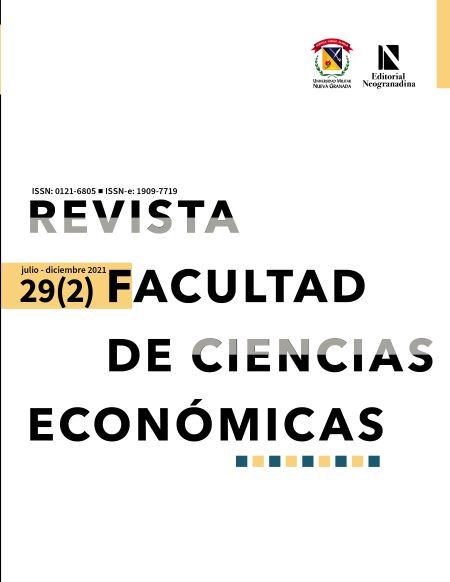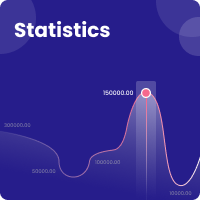The Exchange Rate and its Impacts on Colombian Economic Aggregates
a FAVAR Approach
Abstract
This document identifies the relationship between the exchange rate and the different macroeconomic aggregates in the Colombian economy, mainly in production, consumption, inflation, trade balance, unemployment rate and investment, through the methodology Factor Augmented var (FAVAR). It is identified that an appreciation of the dollar generates significant changes in economic activity, the trade balance, prices, consumption, and public spending.
Downloads
References
Alonso, G., Hernández, J. N., Pulido, J. D. y Villa, M. (2008). Medidas alternativas de tasa de cambio real para Colombia (Borradores de Economía, 514, 20-81). Banco de la República. https://doi.org/10.32468/be.514
Balke, N. S., Brown, S. y Yücel, M. (2002). Oil price shocks and the U.S. Economy: Where does the asymmetry originate? Energy Journal, 23(3), 27-52. https://doi.org/10.5547/ISSN0195-6574-EJ-Vol23-No3-2
Bai, J. y Ng, S. (2002). Determining the Number of Factors in Approximate Factor Models. Econometrica, 70(1), 191-221. https://doi.org/10.1111/1468-0262.00273
Banco de la República, Colombia. (s. f.). Índice de la tasa de cambio real (itcr). https://www.banrep.gov.co/es/estadisticas/tasas-de-cambio-sector-externo-y-derivados
Bergstrand, J. H. (1985). The Gravity Equation in International Trade: Some Microeconomic Foundations and Empirical Evidence. Review of Economics and Statistics, 67(3), 474-481. https://doi.org/10.2307/1925976
Bernanke, B. S., Boivin, J. y Eliasz, P. (2005). Measuring the Effects of Monetary Policy: A Factor-Augmented Vector Autoregressive (favar) approach. The Quarterly Journal of Economics, 120(1), 387-422. https://doi.org/10.1162/0033553053327452
Bernanke, B. S. (1983). Irreversibility, Uncertainty, and Cyclical Investment. Journal of Economics, (98)1, 85-106. https://doi.org/10.2307/1885568
Branson, W. H. y Love, J. P. (1988). The Real Exchange Rate, Employment and Output in Manufacturing in the U.S. and Japan. National Bureau of Economic Research, Working Paper 2491. https://doi.org/10.3386/w2491
Bjørnland, H. C. (2003). The Economic Effects of North Sea Oil on the Manufacturing Sector. Scottish Journal of Political Economy, 45(5), 553-585. https://doi.org/10.1111/1467-9485.00112
Burgess, S. M. y Knetter, M. M. (1998). An International Comparison of Employment Adjustment to Exchange Rate Fluctuations. Review of International Economics, 6(1), 151-163. https://doi.org/10.1111/1467-9396.00094
Candelo, J. M. (2021). Índice mensual de incertidumbre financiera y económica (imife) para la economía colombiana. Lecturas de Economía, (95). https://doi.org/10.17533/udea.le.n95a343318
Candelo, J. M. (2018). Impactos indirectos de la tasa de cambio y los precios del petróleo en una economía no petrolera: aproximaciones vecm y var para el Valle del Cauca, Colombia. Finanzas y Política Económica, 10(2), 403-436. https://doi.org/10.14718/revfinanzpolitecon.2018.10.2.9
Clarida, R.; Galí J. y Gertler, M. (2001). Optimal Monetary Policy in Open versus Closed Economies: An Integrated Approach. American Economic Review, (91)2, 248-52. https://doi.org/10.1257/aer.91.2.248
Corden, W. M. (1984). Booming Sector and Dutch Disease Economics: Survey and Consolidation. Oxford Economic Papers, 36(3), 359-380. https://doi.org/10.1093/oxfordjournals.oep.a041643
Corsetti, G.; Dedola, L. y Leduc, S. (2010). Optimal Monetary Policy in Open Economies. En B. M. Friedman y M. Woodford, (Eds.), Handbook of Monetary Economics, vol. 3, (pp. 861-933). Elsevier. https://doi.org/10.1016/B978-0-444-53454-5.00004-9
dane. (s. f). Cuentas nacionales anuales. https://www.dane.gov.co/index.php/estadisticas-por-tema/cuentas-nacionales
Davis, S. J. y Haltiwanger, J. (2001). Sectoral job creation and destruction responses to oil price changes. Journal of Monetary Economics, 48(3), 465-512. https://doi.org/10.1016/S0304-3932(01)00086-1
Demir, F. (2010). Exchange Rate Volatility and Employment Growth in Developing Countries: Evidence from Turkey. World Development, 38(8), 1127–1140. https://doi.org/10.1016/j.worlddev.2009.12.019
Dickey, D. A. y Fuller, W. A. (1979/2012). Distribution of the Estimators for Autoregressive Time Series with a Unit Root. Journal of the American Statistical Association, 74(366a), 427- 431. https://doi.org/10.1080/01621459.1979.10482531
Dozovic, E. y Pripuzic, D. (2013). Industry Specific Real Effective Exchange Rates in Central and Eastern European Countries [conferencia]. The 8th Young economists’ seminar to 19th Dubrovnik Economic Conference, Croacia, https://www.hnb.hr/documents/20182/120691/dozovic-pripuzic2.pdf/63f6396a-3ad0-4118-98cd-fbb36a8c3142.
Echavarría, J. J. y Arbeláez, M. A. (2003). Tasa de cambio y crecimiento económico en Colombia durante la última década. (Borradores de Economía, 338). Banco de la República. https://www.banrep.gov.co/docum/ftp/borra338.pdf
Égert, B. y Leonard, C. (2008). The Dutch disease in Kazakhstan: An empirical investigation. Focus on European Economic Integration, (2), 85-108.
Forni, M., Hallin, M., Lippi, M. y Reichlin, L. (2005). The Generalized Dynamic Factor Model: One-Sided Estimation and Forecasting. Journal of the American Statistical Association, 100(471), 830-840. https://doi.org/10.1198/016214504000002050
Frenkel, R. y Ros, J. (2006). Unemployment and the real exchange rate in Latin America. World Development, 34(4), 631-646. https://doi.org/10.1016/j.worlddev.2005.09.007
Galindo, A., Izquierdo, A. y Montero, J. M. (2007). Real exchange rates, dollarization and industrial employment in Latin America. Emerging Markets Review, 8(4), 284–298. https://doi.org/10.1016/j.ememar.2006.11.002
Geweke, J. (1976). The dynamic factor analysis of economic time series models. University of Wisconsin, 22(1), 37-54.
González, S. y Hernández, E. (2016). Impactos indirectos de los precios del petróleo en el crecimiento económico colombiano. Lecturas de Economía, (84), 103-141. https://doi.org/10.17533/udea.le.n84a04
Guzman, M., Ocampo, J. A. y Stiglitz, J. E. (2018). Real exchange rate policies for economic development. World Development, 110, 51-62. https://doi.org/10.1016/j.worlddev.2018.05.017
Hamilton, J. D. (2003). What is an oil shock? Journal of Econometrics, 113(2), 363-398. https://doi.org/10.1016/S0304-4076(02)00207-5
Hamilton, J. D. (1989). A New Approach to the Economic Analysis of Nonstationary Time Series and the Business Cycle. Econometrica, 52(7), 357-384. https://doi.org/10.2307/1912559
Haltiwanger J., Kugler, A., Kugler, M., Micco, A. y Pagés, C. (2004). Effects of tariffs and real exchange rates on job reallocation: evidence from Latin America. The Journal of Policy Reform, 7(4), 191-208. https://doi.org/10.1080/1384128042000285183
Hua, P. (2007). Real exchange rate and manufacturing employment in China. China Economic Review, 18(3), 335–353. https://doi.org/10.1016/j.chieco.2007.02.001
International Monetary Fund (imf). (s. f.) World economic outlook databases. https://www.imf.org/en/Publications/SPROLLS/world-economic-outlook-databases#sort=%40imfdate%20descending
Kilian, L. y Vigfusson, R. (2011). Are the responses of the u.s. economy asymmetric in energy price increases and decreases? Quantitative Economics, 2. https://doi.org/10.3982/QE99
Kilian, L. (2009). Not All Oil Price Shocks Are Alike: Disentangling Demand and Supply Shocks in the Crude Oil Market. American Economic Review, 99(3), 1053-69. https://doi.org/10.1257/aer.99.3.1053
Lartey, E. (2008). Capital Inflows, Resource Reallocation and the Real Exchange Rate. International Finance, 11(2), 131-152. https://doi.org/10.1111/j.1468-2362.2008.01222.x
Lee, K., Ni, S., Ratti, R.A., 1995. Oil Shocks and the Macroeconomy: The Role of Price Variability. Energy Journal, 16(4), 39-56. https://doi.org/10.5547/ISSN0195-6574-EJ-Vol16-No4-2
Leung, D. y Yuen, T. (2007). Labour Market Adjustments to Exchange Rate Fluctuations: Evidence from Canadian from Canadian Manufacturing Industries. Open Economies Review, 18(2), 177-189. https://doi.org/10.1007/s11079-007-9007-y
Mendoza, O. y Vera, D. (2010). The Asymmetric Effects of Oil Shocks on an Oil-Exporting Economy. Cuadernos de Economía, 47(135), 3-13. https://doi.org/10.4067/S0717-68212010000100001
Gov.co, (s. f.). Cifras, datos e indicadores. https://www.minhacienda.gov.co/webcenter/portal/Estadisticas
Mork, K. A. (1989). Oil and the Macroeconomy When Prices Go Up and Down: An Extension of Hamilton’s Results. Journal of Political Economy, 97(3), 740-744. https://doi.org/10.1086/261625
Mork, K. A., Olsen, O. y Mysen, H. T. (1994). Macroeconomic Responses to Oil Price Increases and Decreases in Seven oecd Countries. The Energy Journal, 15(4). https://doi.org/10.5547/ISSN0195-6574-EJ-Vol15-No4-2
Neary, P. (1988). Determinants of the equilibrium real exchange rate. American Economic Review, 78(1), 210-215. https://www.jstor.org/stable/1814708
Ostry, J. D. (1988). The Balance of Trade, Terms of Trade, and Real Exchange Rate: An Intertemporal Optimizing Framework. imf Staff Papers, 35(4), 541-573. https://doi.org/10.2307/3867110
Otero, J. (1997). Los determinantes de la tasa de cambio real en Colombia. Coyuntura Económica, 169-180. http://hdl.handle.net/11445/3267
Oviedo-Gómez, A. y Candelo-Viafara, J. M. (2020). Mining and Energy Commodity Price Effects on Colombian Economy. Cuadernos de Administración, 36(67), 93-108. https://doi.org/10.25100/cdea.v36i67.8641
Oviedo, A. F. y Sierra, L. P. (2019). La importancia de los términos de intercambio en la economía colombiana. Revista de la Cepal, (128), 125-154. https://doi.org/10.18356/73298cb5-es
Peláez, J. T. y Sierra, L. P. (2016). Does Industrial Employment React to Movements in the Real Exchange Rate? An Empirical Analysis for Colombia, 2000-2010. Latin American Journal of Economics, 53(1), 36-39. http://dx.doi.org/10.7764/LAJE.53.1.39
Perilla, J. R. (2010). El impacto de los precios del petróleo sobre el crecimiento económico en Colombia. Revista de Economía del Rosario, 13(1), 75-116.
Phillips, P. C. y Perron, P. (1988). Testing for a unit root in time series regression. Biometrika, 75(2), 335-346. https://doi.org/10.1093/biomet/75.2.335
Pindyck, R. S. (1991). Irreversibility, Uncertainty, and Investment. Journal of Economic Literature, 29, 1110-1148. https://doi.org/10.3386/w3307
Poncela, P., Senra, E. y Sierra, L. P. (2017). Long-term links between raw materials prices, real exchange rate and relative de-industrialization in a commodity-dependent economy: empirical evidence of “Dutch disease” in Colombia. Empirical Economics, 52(2), 777-798. https://doi.org/10.1007/s00181-016-1083-7
Reinhart, C. M. (1995). Devaluation, Relative Prices and International Trade: Evidence from Developing Countries. Staff Papers (International Monetary Fund), 42(2), 290-312. https://doi.org/10.2307/3867574
Revenga, A. (1992). Exporting Jobs? The Impact of Import Competition on Employment and Wages in U. S. Manufacturing. The Quarterly Journal of Economics, 107(1), 255–284. https://doi.org/10.2307/2118329
Rhenals, R. y Saldarriaga, J. (2007). Tasa de cambio real y crecimiento económico en Colombia, 1995-2006: Una exploración inicial. Perfil de Coyuntura Económica, (9), 5-19.
Sahin, A. y Cengiz, S. (2011). The real exchange rate and the employment market: Evidence for Turkey by panel cointegration analysis. African Journal of Business Management, 5(14), 5845–5854. https://doi.org/10.5897/AJBM10.1162
Sierra, L. P. y Manrique, L. (2014). Impacto del tipo de cambio real en los sectores industriales de Colombia: una primera aproximación. Revista de la Cepal, 114, 127-142. https://doi.org/10.18356/4f500c15-es
Sinnott, E., Nash, J. y De la Torre, A. (2011). Natural Resources in Latin America and the Caribbean: Beyond Booms and Busts? World Bank Latin American and Caribbean Studies. World Bank. https://doi.org/10.1596/978-0-8213-8482-4
Stock, J. H. y Watson, M. W. (2011). Dynamic Factor Models. En M. P. Clements y D. F. Hendry. (Eds.), Oxford Handbook on Economic Forecasting (35-59). Oxford University Press. https://doi.org/10.1093/oxfordhb/9780195398649.013.0003
Stock, J. H. y Watson, M. W. (2005). Implications of dynamic factor models for var analysis. National Bureau of Economic Research, 11467, 1-67.
Stock, J. H. y Watson, M. W. (2002). Macroeconomic Forecasting Using Diffusion Indexes. Journal of Business & Economic Statistics, 20(2), 147-162. https://doi.org/10.1198/073500102317351921
Svensson, L. E. O. (2000). Open-Economy Inflation Targeting. Journal of International Economics, 50(1), 155-83. https://doi.org/10.1016/S0022-1996(98)00078-6
Vergara, S. (2005). Dinámica laboral de la industria en Chile. Revista de la Cepal, (86), 147-166. https://doi.org/10.18356/de1e3ce1-es

| Article metrics | |
|---|---|
| Abstract views | |
| Galley vies | |
| PDF Views | |
| HTML views | |
| Other views | |











